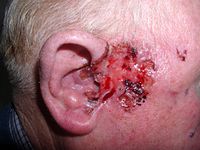
Photo from wikipedia
Results: One (3.2%), 6 (19.4%), 9 (29.0%) and 10 (32.3%) were defined as NCCN low(LR), intermediate(IR), high(HR) and very high-risk (VHR), respectively; 5 (16.1%) presented with M1 at diagnosis. The… Click to show full abstract
Results: One (3.2%), 6 (19.4%), 9 (29.0%) and 10 (32.3%) were defined as NCCN low(LR), intermediate(IR), high(HR) and very high-risk (VHR), respectively; 5 (16.1%) presented with M1 at diagnosis. The 22-gene GC classified one (3.2%), 7 (22.6%) and 23 (74.2%) as LR (<0.45), IR (0.45-0.6) and HR (>0.6), [hp2] [AS3] respectively. All M1 PCa patients harbored high GC scores (range 0.796-0.955). Of the 9 NCCN HR patients, 5 (55.6%) were downgraded to GC-IR; while the VHR patients were not affected. For the 6 NCCN IR patients, 4 (66.7%) in fact harbored high GC scores (0.6336-0.7458). Variance in GC scores was highest in GS 6-7 tumors (GC range: 0.3594-0.7458). Using the six-tier combined NCCN-GC risk grouping (Spratt et al.), 4 (66.7%) and 1 (16.7%) of 6 IR patients were reclassified as HR and LR, respectively. 4 (44.4%) of 9 HR who were GC-IR were classified as NCCN-CG HR, but 5 (55.6%) patients who were GC-HR were upgraded to NCCN-CG VHR. Lastly, transcriptome profiling by PAM50 signature revealed a higher proportion of basal than luminal subtypes in our East-Asian cohort (25 [80.6%] vs 6 [19.4%]) and a low proportion of ETS+/ERG+/SPINK1+ PCa (4 [12.9%]).
Journal Title: Annals of Oncology
Year Published: 2020
Link to full text (if available)
Share on Social Media: Sign Up to like & get
recommendations!